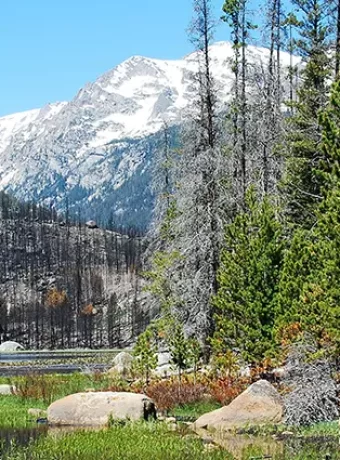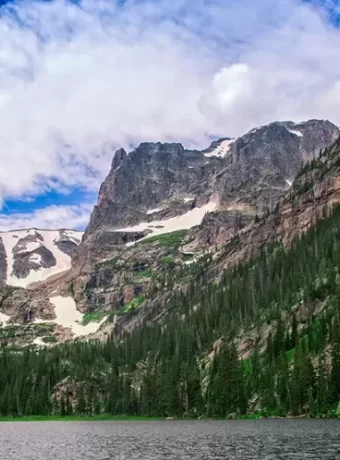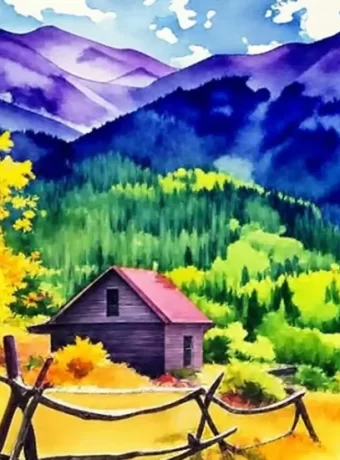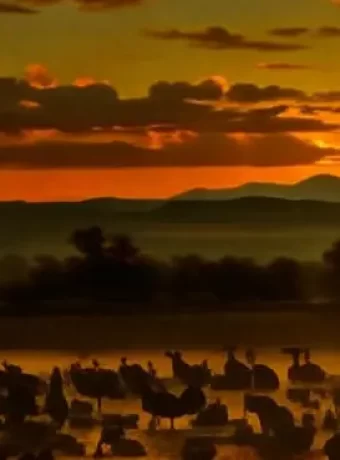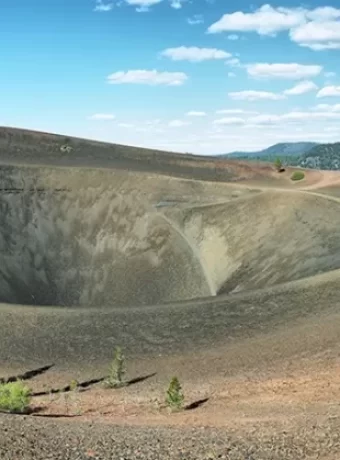17 Top Snowshoeing Trails in Yellowstone Park
Have you ever felt the crunch of snow underfoot, while marveling at a landscape dressed in winter’s finest white? Can you imagine doing so amidst Yellowstone’s untamed wilderness?
I’ll let you in on a secret. Snowshoeing Yellowstone National Park, with its varied terrain and breathtaking vistas, is nothing short of magical.
You might be wondering where to start or what trails are best suited for this wintry adventure. I’m here to help! Get ready as we lace up our boots (or rather, strap on our snowshoes) and delve into exploring the 17 best snowshoeing trails in Yellowstone National Park.
charm. Get ready to witness breathtaking vistas, spot unique wildlife, marvel at the hydrothermal features and conquer deep snow challenges – all that make Yellowstone truly one-of-a-kind.
Yellowstone Wildlife outdoor performance apparel Click Here.
Table Of Contents:
- Exploring the Northeast Ski Trails
- Discovering the Canyon Ski Trails
- Adventurous Snowshoeing in the Tower Area
- Tranquil Snowshoeing in West Yellowstone
- Journeying through the Black Sand Basin
- Safety Tips and Trail Etiquette for Snowshoeing in Yellowstone
- Planning Your Yellowstone Snowshoeing Adventure
- FAQs in Relation to 17 Best Snowshoeing Trails in Yellowstone National Park
- In Conclusion of Snowshoeing Yellowstone National Park
Exploring the Northeast Ski Trails
As you begin your journey in Yellowstone National Park, the abundance of ski trails will be one of the first things that catch your eye. Snowshoe aficionados can find the ideal blend of diverse topography and stunning sights along the Northeast Ski & Snowshoe Trails.
The Northeast Ski & Snowshoe Trails are some of the best ones to explore. Whether it’s a cold dry day or there’s deep snow underfoot, these trails offer something special.
Navigating through Lamar Valley
Lamar Valley holds its own charm during winter. The surface area covered in sparkling white snow offers an incredible setting for an unforgettable snowshoeing journey. Unplowed roads and trails in Yellowstone are open for exploration on skis or snowshoes, providing the perfect opportunity to witness majestic wildlife. So get ready.
A visit here isn’t just about exercise; it also gives you ample opportunities to witness wildlife sightings such as herds of trumpeter swans gliding across icy ponds or bald eagles soaring high above – each adding their touch to your magical time spent here.
The beauty is that despite weather conditions varying significantly between regions within the park, help from visitor centers along with local ski shops ensure your safety while navigating this snowy wonderland.
Ski Trail Conditions – What To Expect?
No two days are alike when dealing with nature – especially when exploring Yellowstone’s northeast ski trails. Depending on recent weather patterns, trail conditions can range from smooth packed powder perfect for easy strides to more challenging crusty or ice-filled tracks requiring careful navigation skills. This variation makes each visit unique, but don’t worry – Yellowstone National Park Service always updates trail conditions regularly.
It’s essential to be aware of snow conditions before you start your journey. They can drastically affect the difficulty level and overall experience on these trails. Always remember: a good adventurer never underestimates Mother Nature.
The Beauty Of The Northeast Ski Trails
the eye can see. The snow-covered landscapes, dotted with pine trees and marked by pristine ski trails, offer a sight that is truly breathtaking. So whether you’re an avid skier or just love the beauty of winter wonderlands, the northeast’s ski trails promise unforgettable views and thrilling experiences.
Embark on an unforgettable adventure with Yellowstone’s Northeast Ski & Snowshoe Trails. They’re perfect for any weather, offering varied terrain and breathtaking views. Enjoy the magical wildlife sightings in Lamar Valley, and remember that all unplowed roads are open to explore. Make sure you check trail conditions before you start because they can change daily. But don’t worry – local help is always available to ensure your safety.
Discovering the Canyon Ski Trails
The secrets of Canyon Ski Trails are waiting for you to discover. But, don’t forget that an overnight backcountry trip in Yellowstone needs a permit.
Catching the Snow Conditions Just Right
Snow conditions on canyon ski trails can be unpredictable, making it crucial to check weather updates regularly. Early mornings after fresh snowfall create magical moments with sparkling white vistas stretching out before you.
Frequent visitors often favor early February as the perfect time to experience these trails. The combination of cold dry air and deep snow provides an exhilarating glide through this winter wonderland.
Nearby Facilities: More Than Just Comforts
Beyond natural beauty, convenient facilities add comfort and safety to your journey. Visitor centers provide timely information about trail conditions while ski shops equip you with necessary gear tailored for varying terrain features.
You might think restrooms are mundane until you’ve been on a long trail. Strategically located along the routes, they offer much-needed relief points during your adventure-filled day.
Your First Steps into Wonderland: Where Trail Starts
The thrilling excitement begins at Artist Point parking area where most canyon ski trails start their course. As soon as you strap up those skis or buckle your snowshoes, Yellowstone’s breathtaking landscape starts unveiling its wonders right under your feet.
Mindful Adventures Await You at Upper Terrace Loop Trail
- A must-try is the Upper Terrace Loop trail near Mammoth Hot Springs which offers picturesque views over steamy terraces painted by nature herself. This is one of my favorite places to take first timers and friends from out of state.
- If getting close to the wilderness is your thing, turn left on the trail and find yourself at the edge of a dense forest echoing with sounds of unseen inhabitants.
- Take a moment here. You might spot bald eagles soaring high or hear trumpeter swans serenading each other near Swan Lake Flat.
Remember though, venturing off-trail isn’t advised due to hydrothermal features that can be hidden under snow.
Rim and Lower Rim. Don’t forget to explore the Brink of Upper Falls trail, too. All these paths provide stunning views of Yellowstone’s unique landscapes. But remember, safety is key in such an unpredictable environment. So make sure you’re prepared with appropriate gear and knowledge before heading out into the wilderness.
Adventurous Snowshoeing in the Tower Area
The Tower Area is a paradise for adventurous snowshoers, offering some of the most breathtaking views and challenging trails. The geothermal features along these groomed trails add an element of surprise to your journey.
When you think about Yellowstone National Park, chances are images of towering mountains, dense forests, and abundant wildlife spring to mind. But did you know that this iconic park also boasts a winter wonderland ripe for exploration on snowshoes?
The Challenge of Calcite Springs Overlook Trail
A particular highlight in the Tower area is tackling the thrilling Calcite Springs Overlook Trail. This trail will test your stamina with its steep climbs but reward you with panoramic views that make every step worth it.
This demanding yet rewarding trail offers an adrenaline rush like no other. With each ascending step, as the cold air fills your lungs and crunching snow resonates underfoot, there’s an unspoken promise – at peak elevation awaits unparalleled vistas over Yellowstone’s landscape.
Safety precautions cannot be stressed enough when venturing into such wild terrains: skiing or hiking alone can pose risks; always ensure to have company alongside for safety reasons. Also remember staying hydrated isn’t just a summer concern – even amidst winter chill it remains vital. Lastly but importantly don’t approach wildlife if encountered on trails- keep safe distances instead.
If we’re talking about pure adventure blended with stunning scenery then Tower Ski & Snowshoe Trails surely ranks high amongst best places across US parks.
Tower Fall Trail
You won’t want to miss out on another gem within this area – the Tower Fall Trail. Starting at the parking lot, this trail descends around 1000 feet over a distance of just one mile. The final reward? A stunning view of Yellowstone’s iconic 132-foot waterfall framed by snow-clad pine trees.
As you journey along these trails, remember to pause and appreciate the magical winter scenes that surround you. Imagine pristine white landscapes punctuated by steamy geysers – a truly awe-inspiring sight.
and don’t forget to layer up. Navigating the snowy trails can be a challenge, so gear up with sturdy boots and reliable equipment. Always respect nature’s power – never stray from marked paths or venture into restricted areas. After all, Yellowstone isn’t just about the thrill; it’s about respecting and appreciating our natural world.
Tranquil Snowshoeing in West Yellowstone
Experience tranquility and the beauty of nature while snowshoeing in West Yellowstone.
The peace and quiet of West Yellowstone are hard to match. The untouched snow conditions, coupled with the mesmerizing landscape, make it a haven for cross-country skiing and snowshoe trails enthusiasts.
You may not find groomed ski tracks here, but that’s part of what makes this area so special. It gives you the freedom to carve your own path through deep layers of fresh powder. However, be mindful that these pristine trails are not checked daily by park services – nature reigns supreme out here.
A Look at Ski Tracks & Weather Conditions
While the thrill lies in creating your unique route across the varied terrain surface area, don’t underestimate Mother Nature. Keep an eye on local weather forecasts before venturing out as sudden changes can occur during winter months.
Cold dry winds could create more challenging conditions or turn magical times into risky adventures if you’re unprepared. But hey – adventure is why we strap on those snowshoes in the first place.
Snowshoe Walk Through Wildlife Wonderland
What sets West Yellowstone apart from other places? Its rich wildlife. On any given day while trudging along a ski trail or embarking on a snowy trek near Madison River canyon areas – remember to keep an eye open for trumpeter swans taking flight or bald eagles perched high above riverbanks.
In this icy wilderness bordered by forests and vast meadows, animal sightings are quite common; so don’t forget your camera. You never know when a rare photo opportunity might present itself amidst your tranquil escapade.
Tips for a Safe Snowshoeing Adventure
West Yellowstone’s vast wilderness can be challenging. Hence, it’s important to plan well and prioritize safety on your snowshoeing adventure.
Never venture out alone – always bring a friend along. Ensure you stay nourished by bringing along adequate sustenance to keep your strength up throughout the day. Above all, remember to respect wildlife by maintaining a safe distance from any animals you might come across.
Yellowstone Snowshoeing Tips:
West Yellowstone offers a tranquil, nature-filled snowshoeing experience with its untouched snow conditions and rich wildlife. Remember to carve your own path carefully, watch the weather, respect the animals you encounter and always prioritize safety. Embrace this winter adventure that lets you step into an unspoiled wilderness.
Snowshoe Walk Through Wildlife Wonderland
What sets West Yellowstone apart from other places? Its rich wildlife. On any given day while trudging along a ski trail or embarking on a snowy trek near Madison River canyon areas – remember to keep an eye open for trumpeter swans taking flight or bald eagles perched high above riverbanks.
In this icy wilderness bordered by forests and vast meadows, animal sightings are quite common; so don’t forget your camera. You never know when a rare photo opportunity might present itself amidst your tranquil escapade.
Tips for a Safe Snowshoeing Adventure
West Yellowstone’s vast wilderness can be challenging. Hence, it’s important to plan well and prioritize safety on your snowshoeing adventure.
Never venture out alone – always bring a friend along. Ensure you stay nourished by bringing along adequate sustenance to keep your strength up throughout the day. Above all, remember to respect wildlife by maintaining a safe distance from any animals you might come across.
West Yellowstone offers a tranquil, nature-filled snowshoeing experience with its untouched snow conditions and rich wildlife. Remember to carve your own path carefully, watch the weather, respect the animals you encounter and always prioritize safety. Embrace this winter adventure that lets you step into an unspoiled wilderness.
Bison, Eagle, and a Bull Elk on a Winter’s day in Yellowstone National Park on Outdoor Performance Apparel a great winter layer. Click here to get yours.
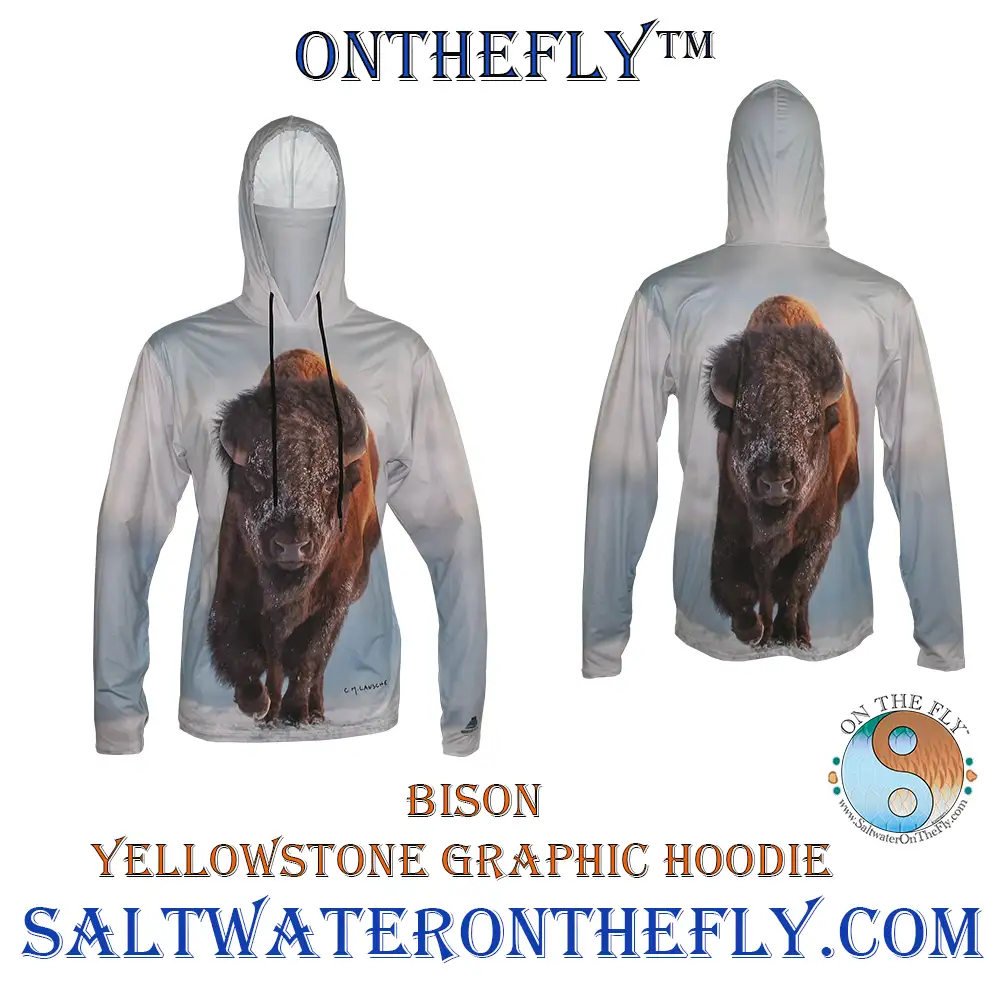
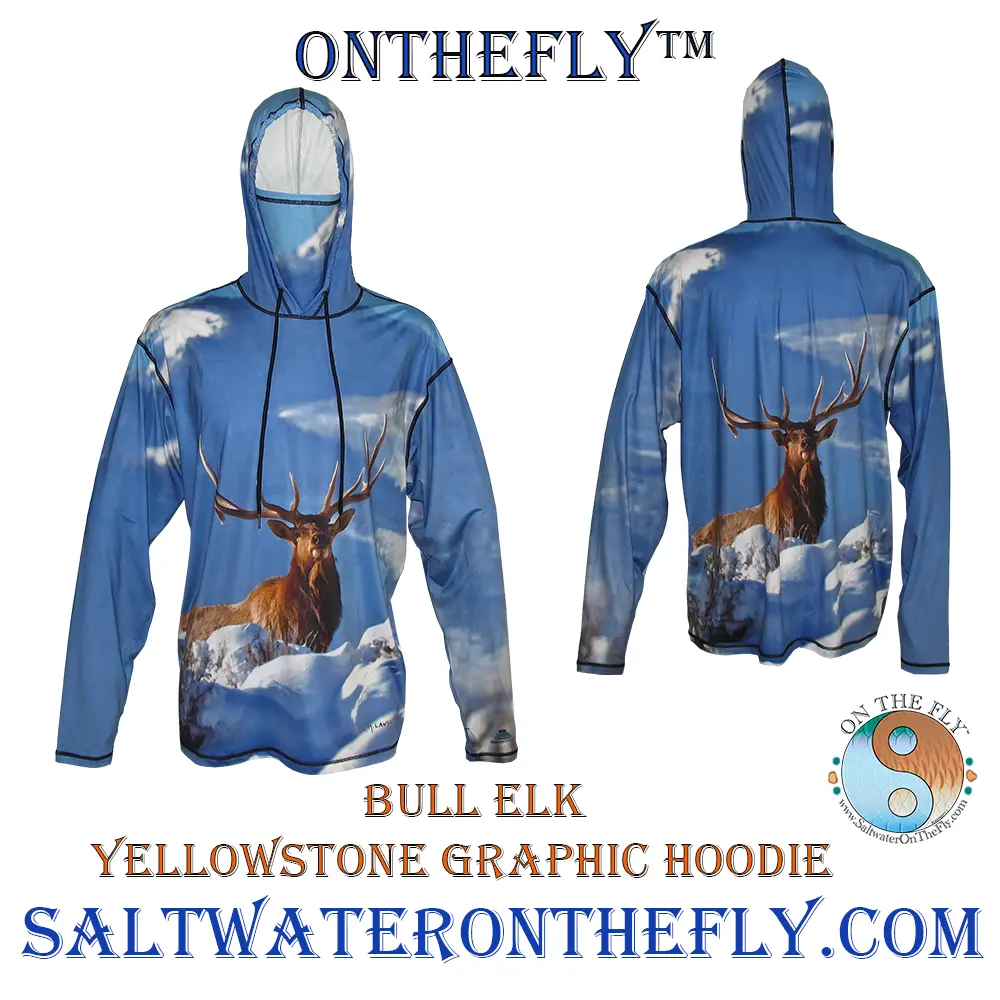
Journeying through the Black Sand Basin
Embark on a memorable journey through the geothermal features of Black Sand Basin.
Black Sand Basin, a lesser-known gem in Yellowstone National Park, offers some of the most fascinating snowshoe trails. Its unique geothermal features add an element of surprise to your adventure.
Navigating Snowy Paths Amidst Geothermal Wonders
One can’t help but marvel at Emerald Pool’s vibrant color or Sunset Lake’s captivating beauty while navigating these groomed trails. The dazzling colors contrast against the cold white snow create scenes straight out of a fantasy novel.
A trip here isn’t complete without visiting Cliff Geyser – a remarkable feature spewing boiling water high into the freezing winter air. It’s like watching Mother Nature defy herself in spectacular fashion.
Snowshoeing Under Winter Sky Canopy
Beneath Yellowstone’s vast winter sky canopy, Black Sand Basin takes on a magical quality during winters as heavy blankets of snow transform it into one giant playground perfect for adventurers with their heart set on exploring via Old Faithful Ski & Snowshoe Trails.
If you’re lucky enough, you might even spot trumpeter swans taking flight or bald eagles soaring above – they’re both common sights around these parts during wintertime. But remember: keep your distance and respect wildlife space because we are guests in their homes after all.
Park Service Advice For A Safe Journey
- Check trail conditions: Before embarking on your snowshoe journey, it’s crucial to talk to park rangers. They can provide specific information about trail conditions and any possible closures due to weather or wildlife activity.
- Dress appropriately: In the deep Yellowstone winter, temperatures often drop below freezing point. Make sure you’re wearing warm clothing that’s suitable for cold, dry climates.
- Safety gear is a must: Remember to carry essential safety equipment like navigation tools and first-aid kits because emergencies don’t announce themselves.
Wrapping things up (but don’t think we’re finished exploring.), Yellowstone National Park’s Black Sand Basin offers a one-of-a-kind snow experience.
Black Sand Basin in Yellowstone National Park is a winter wonderland perfect for snowshoeing. With stunning geothermal features, vibrant colors contrasting the white snow, and potential wildlife sightings, it’s an adventure you don’t want to miss. Just make sure to chat with park rangers about trail conditions and dress warmly. Always carry safety gear because preparation is key when exploring this breathtaking terrain.
Safety Tips and Trail Etiquette for Snowshoeing in Yellowstone
With a wonderland like Yellowstone, snowshoeing opportunities are endless. But before you strap on those shoes and head out into the deep snow, there are some safety measures to consider.
Firstly, proper clothing is crucial. This isn’t just your regular hike; this is winter in one of America’s most famous national parks. Think layers – thermal base layers under waterproof jackets and pants should do the trick. Don’t forget insulated gloves and a warm hat too.
You’ll also need appropriate equipment. Besides quality snowshoes designed for varied terrain, carrying avalanche gear such as beacons, probes or shovels can save lives if things go south.
Knowing Your Way Around
A sense of direction can prove invaluable when navigating through miles of snowy trails that might look similar at first glance. Familiarize yourself with trail markers by visiting Alerts page. Maps aren’t only helpful but necessary to avoid getting lost in Yellowstone’s expansive landscape.
If you’re new to all this cold dry fun or feel unsure about venturing alone into unfamiliar territory? There’s no shame in asking park rangers for help – they’re happy to share their wealth of knowledge with visitors.
Beware Of Wildlife Encounters
The magic doesn’t stop when animals cross your path while snowshoeing – from bald eagles soaring overhead to trumpeter swans gracing frozen lakesides it’s quite an experience. Yet remember these large animals are not pets – keep distance & respect their space.
Navigating Uphill Yield
In cases where the trail is narrow and two groups meet, the one going downhill should yield to those moving uphill. It’s much easier for a descending party to get back into rhythm after stopping than it is for those climbing.
Trail Etiquette
Don’t forget, we’re not alone on these trails. Cross-country skiers and other snowshoers enjoy them too.
Yellowstone Snowshoeing Tips:
Embrace the thrill of Yellowstone’s winter wonderland with snowshoeing, but make sure you’re geared up right. Layered clothing and quality equipment are a must. Get familiar with trail markers and always have a map handy to avoid getting lost in this vast landscape. Respect wildlife from a distance, yield to uphill travelers on narrow trails. And let’s not forget, we’re here for an adventure so soak it all in.
Planning Your Yellowstone Snowshoeing Adventure
Your ultimate winter adventure is within reach. Begin planning your winter adventure in Yellowstone National Park with an experienced guide or explore the vastness and variety of 2 million acres on a self-led snowshoeing expedition.
The beauty of snowshoeing in Yellowstone National Park lies in its vastness and variety. With more than 2 million acres at your disposal, there are countless opportunities for thrilling journeys on both guided tours and self-led expeditions along vehicle roads.
Picking the Perfect Trail
To start off, consider what kind of experience you’re after. Do you crave serene landscapes blanketed with deep snow? Or do hot springs steaming against a cold dry sky excite your senses?
If it’s the former, trails around West Yellowstone Ski Area might be right up your alley. On the other hand, Mammoth Hot Springs offers magical experiences with hydrothermal features creating fantastical icy formations during winter months. Visitor Centers can provide trail conditions to make sure that whichever path you choose matches not only your desires but also current weather conditions.
Navigating Your Route: Safety First.
Remember that preparation is key when venturing out onto any national park service ski trail. Weather can change rapidly in these high-altitude environments leading to sudden storms or drops in temperature even if sunshine was forecasted just hours earlier. Therefore, packing adequate gear such as thermal layers and waterproof outerwear should be top priority.
Exploring Yellowstone’s Diverse Terrain
Traversing the snow on snowshoes offers a variety of landscapes to explore, from thick woodlands to sprawling fields and steep mountainsides. The park’s wide-ranging landscape encompasses everything from dense forests to vast meadows and rugged mountainsides, offering something for every level of adventurer.
Performance Outdoor Apparel in great fly fishing Graphic Hoodies Click Here.
Take the Lone Star Geyser Loop Trail, for instance. It’s a real show-stopper with its stunning views.
the undulating meadows to the dense, snow-laden forests. If you’re seeking a more guided experience, consider joining ranger-led tours or private guides who can enrich your adventure with local knowledge and history. But remember, Yellowstone in winter is as unpredictable as it’s beautiful; so always respect wildlife from a distance and stay safe on marked trails.
FAQs in Relation to 17 Best Snowshoeing Trails in Yellowstone National Park
Can you snowshoe in Yellowstone National Park?
Absolutely, Yellowstone welcomes snowshoers. Unplowed roads and trails are open for this snowy adventure.
What is the most popular hiking trail in Yellowstone National Park?
The Old Faithful area, particularly the Geyser Basin, attracts many hikers due to its famous geysers and hot springs.
What is the most difficult hike in Yellowstone?
The Sky Rim Trail challenges even seasoned hikers with steep climbs and long distances but rewards with unmatched views.
What are the best snowshoeing trails in Glacier National Park?
Piegan Pass and Avalanche Lake trails provide top-notch experiences for snowshoers seeking a winter wonderland at Glacier National Park.
In Conclusion of Snowshoeing Yellowstone National Park
Exploring the 17 best snowshoeing trails in Yellowstone National Park is an adventure like no other. You’ve discovered how to navigate through Lamar Valley, unveil the secrets of Canyon Ski Trails, and tackle challenging paths such as Calcite Springs Overlook Trail.
You now know that tranquility awaits you in West Yellowstone and a memorable journey lies ahead at Black Sand Basin. Remember safety measures are key – be prepared with proper clothing and equipment for snowshoeing Yellowstone National Park
Your understanding of trail etiquette will protect both you and wildlife on your adventures. Lastly, planning your trip wisely by checking conditions before heading out can make all the difference.
Yellowstone’s varied terrain calls for explorers ready to brave its deep snow challenges. Strap on those snowshoes; winter magic awaits!


